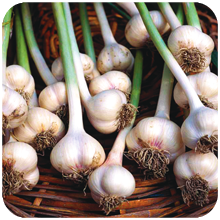
Garlic (Allium sativum) is a biennial plant with long leaves. The main edible part garlic bulb is made up of several white cloves. When the plant is young, its fresh leaves are used for culinary purposes. Garlic grows to a height of 60-90 cm. Garlic is grown in autumn (September-October) or spring (March-April), when planted in the ground, the cloves are sown at a distance of 25-30 cm.
Chemical composition – Garlic contains alliin having distinct odor derived from the sulfur containing amino acid cysteine. When garlic bulbs are crushed, alliin is converted into another compound called allicin. Allicin is then broken down to a compound called ajoene, substance that inhibits blood vessel blockage, clots and atherosclerosis. Allicin is a powerful amino acid that gives distinct smell to garlic and main substance responsible for pharmacological properties of the plant. Garlic also contains germanium, magnesium, selenium, vitamin A, vitamin C, essential oil of which 0.5% is made up of components containing sulfur, zinc.
Properties – Anthelmintic antibacterial, antitumor, anticoagulant, antioxidant, antiseptic, antispasmodic, antiviral, anticoagulant, carminative, aphrodisiac, cholagogue, diaphoretic, digestive, strengthens, stimulates or tones the stomach, diuretic, expectorant and accelerates the functional activity of the tissues that produce more energy.
Recommendation – Atherosclerosis, angina, thrombosis, arthritis, high blood pressure, stomach problems, intestinal worms, otitis media, asthma, rheumatic diseases, gout, influenza, whooping cough, sexual diseases, premature aging and dementia, muscle spasms, cramps or convulsions, colic etc..
This plant is incorporated in natural remedies ARTRISALM, PRESSURE DOWN.




